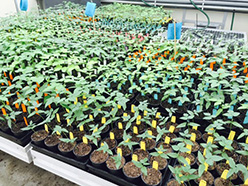Queensland, Australia
April 20, 2017

A new website from QUT's Centre for Tropical Crops and Biocommodities helps mungbean breeders to produce better varieties.
Scientists and mungbean growers around the world now have access to an open-source website containing the latest genetic information on the qualities of 560 accessions of mungbean.
The new website, from QUT’s Centre for Tropical Crops and Biocommodities, provides a database of single nucleotide polymorphism (SNP) genetic markers which can be used to map a variety of traits like disease resistance and yield.
Professor Sagadevan Mundree said the website’s information was open-source to give breeders and research scientists access to new genetic knowledge on important mungbean traits to produce better varieties for Australia’s mungbean growers.
“Mungbeans are one of the fastest growing agricultural crops in Australia, producing a crop worth more than $180 million last season, with the majority of Australia’s crop grown in Queensland,” Professor Mundree said.
“Mungbeans are a staple in Asia and used in everything from poppadums and noodles to desserts.
“The website provides genetic and trait information such as seed size, drought tolerance and disease resistance for 560 mungbean accessions desirable traits.
“The information on this website will allow breeders to produce resilient, high-yield varieties for local areas.”
Dr Brett Williams said the QUT research team performed the bioinformatics and statistics which plant breeders could use to make more informed crosses to include genes they wanted.
“It’s the first time mungbean researchers and breeders are able to see recombination patterns and frequency and why some traits are always inherited together,” Dr Williams said.
PhD student Tom Noble, who worked on the project, said the website was a global resource.
“It will aid in the study and breeding of complex traits such as disease resistance, phenology, drought and heat stress at flowering.”